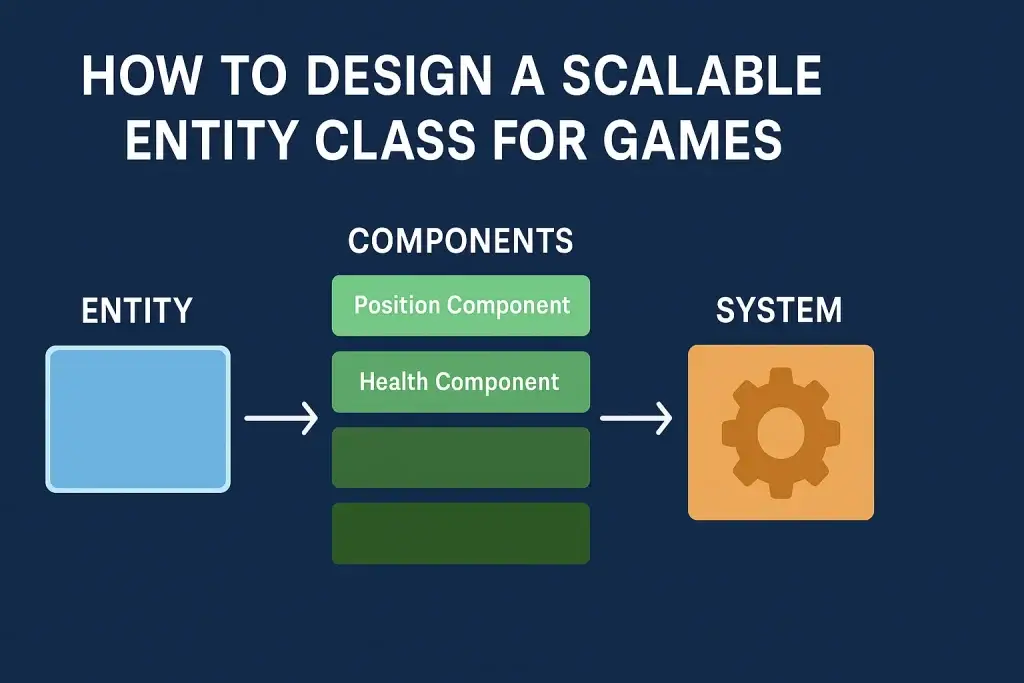
When it comes to designing entities in game development, we inevitably need to discuss the ECS (Entity-Component-System) architecture. Although the term has become somewhat of a buzzword, I’d still like to briefly revisit it here.
What Is ECS?
ECS stands for Entity, Component, and System. It’s a highly efficient data-oriented architecture, particularly useful in large-scale game development, allowing game object design to become more modular and flexible.
Let’s use a metaphor to understand it:
- Entity: Think of it as a simple ID or an empty container. It holds no data or logic by itself—just a unique identifier for something in your game, such as a car, character, or item.
- Component: Components are pure data. They contain no behavior, only values. For example, a
PositionComponentwould store only coordinates (x, y, z), and aHealthComponentwould store a numeric health value. Components can be freely attached to any entity. - System: Systems contain pure logic. They operate on entities that have specific components. For instance, a
MovementSystemwould iterate over all entities that have bothPositionComponentandVelocityComponent, updating their positions based on velocity.
Why Is ECS So Important?
Traditional object-oriented programming (OOP) often results in deep inheritance chains. For example, you might have a Character base class, with Enemy and NPC subclasses. This works fine at first, but as functionality grows, maintaining the inheritance tree becomes cumbersome and error-prone.
ECS offers key advantages:
✅ High Flexibility
You can create any type of game object by composing different components. Want a glowing character? Just add a LightComponent—no need to modify a parent class or create new subclasses.
✅ Superior Performance
Since components are pure data and usually stored contiguously in memory, systems can process them efficiently, taking full advantage of CPU caching. This is crucial when managing large numbers of game entities (e.g., particle systems, enemy swarms).
✅ Clear Code Separation
With logic (systems) and data (components) separated, each system handles a specific task, making the codebase easier to maintain and extend.
In short, ECS embraces the philosophy of composition over inheritance. By breaking down functionality into isolated data and logic modules, you can freely build complex behaviors—just like assembling with LEGO bricks. Unity’s DOTS (Data-Oriented Technology Stack) is a prominent implementation of ECS.
Is ECS Always the Right Choice?
No architecture is one-size-fits-all. ECS is powerful, but not without trade-offs. Consider the following caveats:
1. Steep Learning Curve
Developers accustomed to OOP will need to shift paradigms. Instead of encapsulating data and behavior in one object, ECS requires full separation. This can be disorienting at first—especially during debugging or when designing complex systems.
2. Debugging Complexity
Since data and logic are decoupled, tracing a bug may involve multiple entities, components, and systems. For instance, if a character’s position is wrong, you may need to check:
- Whether the entity has the correct
PositionComponent. - Whether the
MovementSystemcorrectly readsVelocityComponent. - Whether the
PhysicsSystemalters the position. - Whether any other system interferes with the data.
This makes debugging more complicated than the classic “inspect the faulty object” approach. Strong logging and visualization tools are essential.
3. Architectural Complexity
ECS grants flexibility—but good design doesn’t come automatically. To create a maintainable ECS architecture, you must carefully plan:
- Component granularity.
- System responsibilities.
- Entity lifecycle management.
Poor design can lead to:
- Component bloat: Too many tiny components to manage.
- System coupling: Systems overly dependent on each other, undermining decoupling.
4. Not Always the Best Fit
ECS shines in scenarios involving many similar objects—like swarms of enemies, bullets, or particles. But for unique objects with complex behavior (e.g., UI menus or inventory systems), traditional OOP can be more intuitive and efficient.
OOP vs ECS: A Practical Comparison
Let’s demonstrate the difference between classic OOP and ECS with real game examples:
Here’s a side-by-side comparison:
| Feature | Classic OOP | ECS |
|---|---|---|
| Architecture | Inheritance and polymorphism. Player, Enemy must extend Character. | Composition. Entities are defined by the components they have. |
| Data & Logic | Tightly coupled. Data and behavior are in the same class. | Fully separated. Data in components, logic in systems. |
| Flexibility | Low. Adding features often requires changes to class hierarchy. | High. Add a component and a system—no existing code needs to change. |
| Scalability | Poor. Inheritance chains can become complex and brittle. | Excellent. Just create new components/systems to extend functionality. |
| Performance | Lower. Scattered memory and virtual calls can hurt CPU caching. | Higher. Systems process contiguous data efficiently. |
Final Thoughts
ECS code is highly modular and decoupled. The main function essentially acts as a game engine—it creates entities, attaches components, and runs systems to drive the logic. This is the very essence of the ECS architecture.
If you’re designing a scalable, high-performance game architecture, especially one involving large-scale entity management, ECS is worth your consideration. But like all tools, it must be used with care and understanding.
